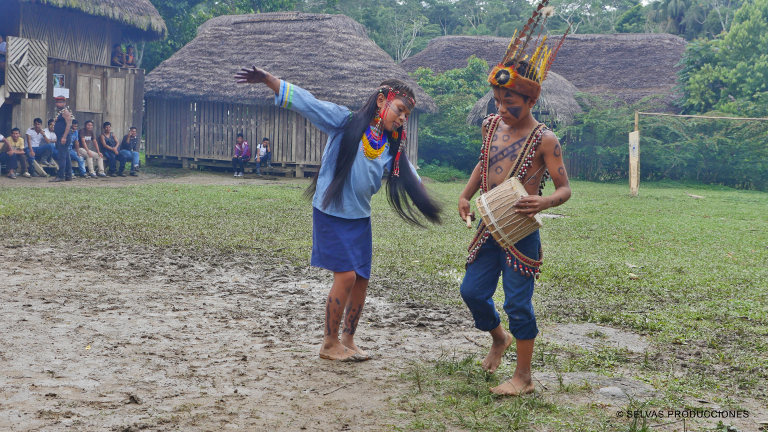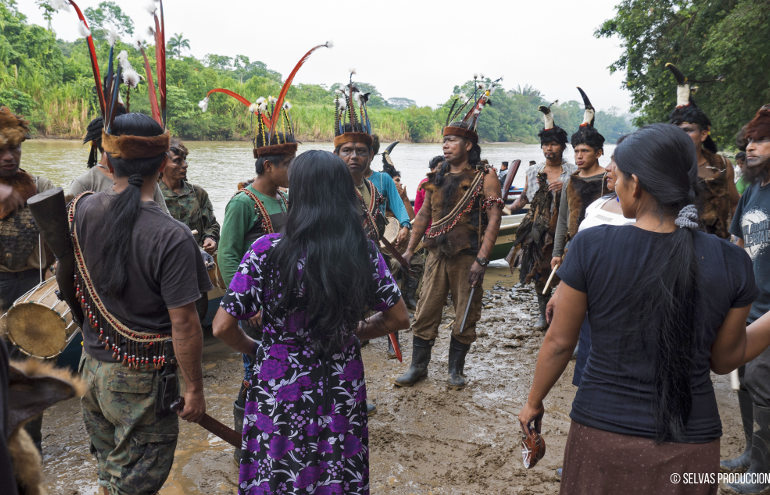An alternative perspective on the COVID-19 pandemic is offered from deep in Ecuador’s Amazon rainforest by “Tiam”, the philosophical ethical thought of the Native Kichwa People of Sarayaku. During these critical moments, we, the Sarayaku, call for a return, a change; a new course proposed from the womb of the living forest itself.
In this time of crisis, as humanity increasingly questions the dominant worldview and opens its eyes to alternatives, we, the Native People of Sarayaku, invite people to consider our philosophy, Tiam. We believe that if the human being accepts this way of life, respectful of the Pachamama, the pain of the planetary wound will be felt, healed, and life will be born again.
At the heart of our philosophy lie concepts that are increasingly part of the public conversation thanks to the pandemic: the importance of solidarity; the recovery of the natural world; the realization of interconnectivity; the need to prioritize life over profit.
Tiam is a counterpoint to the dominant worldview, which sees nature as “other”; as an object for exploitation. This has led to imbalance and severe climatic changes, as well as the current pandemic.
Tiam proposes rebirth, another perspective on being alive. That is to say, it is essential to understand the conception of life; that we live as an embryo in the womb of the Pachamama (Mother Earth). Only in this way will nature be respected, will we live harmoniously, benefiting from the resources that the Pachamama bestows on us.
More than ever, we believe that humanity needs to once again feel the earth; to recognize and declare that the seas, glaciers, volcanoes are alive, living; to feel coexistence within ourselves; to realize that we are nature itself.
This worldview is maintained by native peoples and various other cultures. However, the advance of technology, industry and capital have led to the loss of this essential principle of life. We believe that the rediscovery of this forgotten knowledge is fundamental for our recovery from the pandemic and the wider ecological crisis that threatens all life on the planet.
Tiam also proposes the creation of new indicators of wealth and value, which should measure the richness of a healthy and fertile land, abundant fauna, uncontaminated rivers, life in solidarity, sharing, unity, and the equitable distribution of wealth. It suggests radical changes in the global education system to incorporate this philosophical thought at every stage, from the family unit, through early educational centers to the highest level of study.
Our philosophy is materialized and represented by the Sisa Ñampi, the Border of Life or Living Path of Flowers. This perimeter of flowering trees is being planted around our territory to represent the fragility of life, the ephemeral limit of existence between life and death. In contrast with a border wall of concrete, the Sisa Ñampi marks the Sarayaku territory through the beauty and symbol of the flower.
The Border of Life currently stretches for 100km and will take decades to complete, eventually encircling our territory of 135,000 hectares. It symbolizes our struggle, our peaceful resistance, our commitment to defend the Kawsak Sacha (Living Jungle) from the imminent threat of oil exploitation. It represents the limit of the jungle’s life as it faces the advance of so-called development.
The Sisa Ñampi project was born from the great visions of the realm of the Kawsak Sacha (Living Jungle). It stems from a way of life that respects the invisible beings who we cannot see but can feel, those who feed and fertilize the earth; a way of life that respects the sacredness of the mountains, lagoons, waterfalls, rivers, swamps, grasslands, trees. In such places, where fauna and flora are abundant, dwell the beings known as Amazanga, Sacharuna, Yashingo, and Yakuruna; the protective beings of the Kawsak Sacha and the Sumak Kawsay (Buen Vivir or Life in Harmony). These beings transmitted the concept of the Sisa Ñampi to the Sarayaku shamans (yachaks in the Kichwa language), who in turn communicated it to our people.

Beyond a simple statement, the Border of Life serves to propose the Living Jungle, the Mother Earth, as a conscious living being with legal rights. It symbolizes the existence of another world, of other cultures, of brotherhood. It calls for a life of sharing, in solidarity, as part of the circle; the beginning, the end and the return, to be born again.
Looking back through history, at the legendary struggles and resistance of native peoples from centuries ago, we have always sustained the fight for life, for the rights of the Pachamama. There are historical examples of statements from indigenous peoples calling for the defense of Mother Earth, but sadly these have gone unheeded by governments, and much of society has become deaf and blind.
Our vision of the Sisa Ñampi is for it to adorn the green jungle of the Pachamama so that it is multicolored and even more beautiful. Beholding it heals the soul and gives happiness to the sad and afflicted. The fragrance of the trees crosses the mountains and valleys. Everyone drinks the sweet honey of the flowers, they do not get tired, they are drunk with the honey. There are thousands of birds flocking; majestic parrots, golden parakeets, multicolored hummingbirds. This is the TREE OF LIFE in flower. Its shadow protects the earth, it is so big that Mother Earth feels safe and oxygenated.
We invite people to plant their own Sisa Ñampi, their own flowering border, in their gardens, in their window boxes, to represent our peaceful resistance to the “business as usual” that has led us to the brink of catastrophe; our realization of the fragility and interconnectivity of life; and our adoption of a new way of being in harmony with each other and the Pachamama.
We hope these beautiful borders will spring up all over the world, serving as a source of joy and a visible reminder of the new world that is being born during this time of crisis, of humanity’s return to the earth.
—–
José Gualinga is a leader of the Native People of Sarayaku, an indigenous Kichwa group with 1400 inhabitants living in a remote part of Ecuador’s southern Amazon. Known for their defense of the rights of nature and indigenous peoples, the Sarayaku call themselves the People of the Zenith, referring to an ancient prophecy of their ancestors claiming that they would be a pillar of resistance after other communities had surrendered, a beacon of light as strong as the sun at noon.
In 2012, the Sarayaku won a historic victory at the Inter-American Court of Human Rights, which found that the Ecuadorian State had violated their rights by allowing an oil company to prospect in their territory without consultation. The same year, the Sarayaku created the Kawsak Sacha (Living Forest) Declaration asserting that, as a living entity, their territory is subject to legal rights and demanding that these rights be upheld. The proposal was presented at the global climate change conference, COP21, and to the President of France, François Hollande, in 2015. The Sarayaku have also launched a professional football team to spread the word about oil exploitation in the Amazon; sailed a canoe down the Seine; and created a documentary, Children of the Jaguar, which won Best Documentary at the National Geographic Film Festival in 2012.
In 2020, the Sarayaku are once again under threat, with the Ecuadorian Government’s plan to auction 3 million hectares of largely virgin rainforest to oil companies, including nearly all the Sarayaku territory. For more information, see http://sarayaku.org/ and https://kawsaksacha.org/en/
Article written in collaboration with Bethany Pitts.





